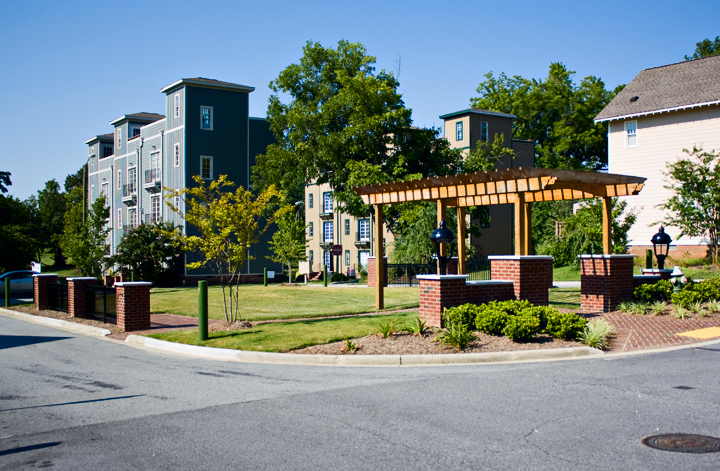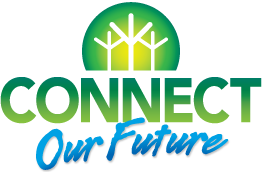Development of vacant or underdeveloped land within existing urbanized areas (city, town, or village) is referred to as infill development. Typically, successful infill development programs focus on improving neighborhood fabric, creating a better mix of jobs and housing, reducing blight, and pulling investment back into the hearts of communities, while not displacing long-time residents.
Why is this important to your community?
Existing land use patterns reveal that more than 48% of land within the CONNECT region is undeveloped or underdeveloped, and it is always both tempting and easy to develop this land before we reinvest in existing communities. However, the overwhelming feedback from CONNECT Our Future participants was that reinvestment in existing communities will not only help to preserve the vitality of communities, but to preserve character and create places that matter. And in fact, this public sentiment has foundations in what has been the trend across the nation in recent years, with infill properties producing much greater value to communities than greenfields development. . An infill development program or strategy can reduce the amount of vacant and underutilized land within existing communities, increase housing and business diversity and densities, and attract private investment. Infill development is a key tool in revitalizing older neighborhoods and activity centers. It can strengthen the character of communities by spreading investment throughout a neighborhood—targeting vacant and underutilized land and building new structures that blend seamlessly within their context.
Skip directly to
How Does It Work?
Resources
Using the Tool
Partners
Where Has It Worked?
Where is it appropriate to use?
What priorities does it address?
What other tools are related?
- Inclusionary Zoning
- Transit Oriented Development Incentives
- Mall-Suburban Corridor Retrofits
- Main Street Programs
- Community-Based Housing Strategies
- GIS Community Assessment
- Educating Officials about Housing Diversity
- Complete Streets
- Brownfield/Greyfield Redevelopment Toolkit
- Workforce Housing Incentives
How does it work?
The success of infill development programs rests on the design of new structures, supporting infrastructure investments (e.g., transportation, streetscape, and parks and open space), providing access to amenities, and the program’s commitment to reshaping the neighborhood as a whole, not just individual properties. Successful programs often involve partnerships between government entities, developers, financial institutions, and neighborhood organizations (e.g., Community Development Corporation – CDCs or a Community Redevelopment Agency – CRA). Cities and counties can encourage infill development by providing incentives to developers and architects. Incentives may include density bonuses, reduced parking requirements, lower development impact fees, tax incentives, and streamlined permitting. Some of the challenges of infill include slow markets that don’t make infill as attractive as it is in times of robust housing and development markets, gentrification that pushes out current residents (particularly if they are lower-income) and a lack of tools to address the particular issues related to infill, such as brownfields concerns, long-abandoned properties, renovation of historic structures, etc. Where those tools do not exist, a concerted effort by infill advocates and local governments may be needed to convince state leaders that infill is not just “nice to do,” it’s essential for the long-term fiscal and social stability of communities.
Resources
- CONNECT Housing Work Group – Comprehensive Regional Housing Strategy, Volume 1 Housing Needs Assessment & Volume 2 Regional AI and Fair Housing Equity Assessment
- Joe Minicozzi’s study—Link
- Joe Morici’s study-Link
- MRSC - Infill Development: Completing the Community Fabric
- City of Austin - Special Use Infill Options and Design Tools
- The Florida Planning Toolbox
- Sample Infill Ordinances
Ready to get started?
Using the Tool
- If your community has not identified target areas for infill and reinvestment, you can do so by:
- Review your CONNECT development status map to identify vacant and underutilized properties within urbanized areas (the map was created in 2012-2013, so be sure to account for development since then). . Clearly identify the properties on a map.
- Utilizing this information, work with partners – municipal officials, real estate professionals/market analysts, developers, architects, city planners, and others – to determine focused investment/redevelopment areas.
- Review existing plans and studies (e.g., Housing Needs Assessment, Brownfields-Greyfields Redevelopment Financing Tools, and Return on Investment Studies) to determine what housing gaps exist in the area, and what other aspects of infill may be appropriate, given past land uses and potential for return on investment
- Once you have done this, or if you already have identified target areas for infill and reinvestment, you may:
- Consider creating a zoning overlay district for this area or submitting a redevelopment plan for approval, with robust public engagement from the community as the plan or district is developed and proposed (see below).
- Revise existing policies and regulations to encourage redevelopment. This may include revising zoning classifications, creating a form-based code overlay, or streamlining the permitting process. .
- Ensure that policies and regulations encourage the development of housing types or uses the community identified as a need (from the Housing Needs Assessment, Neighborhood Plans, Comprehensive Plan, etc.).
- Explore the need and potential for creating a land bank. Land banks, administered by a county redevelopment authority (CRA) or other local government agency, can be used to promote infill development. They acquire vacant or underutilized property and sell it below market rate to promote redevelopment.
- Adopt incentives to promote infill development. Incentives may include tax-based incentives (TIFs, abatements, or credits), lower impact fees, reduced or eliminated parking requirements, low-cost loans, and density bonuses.
- Develop public-private partnerships with local organizations (e.g., non-profit developers, local CDCs, development agencies) to redevelop key infill sites. Consider job-creating uses as well as housing, and/or uses that would be permitted as home businesses, and what it would take to include some neighborhood businesses into redevelopment planning.
- Gather public input. Hold public meetings with residents and local business owners within redevelopment/infill zones to discuss potential strategies related to the larger neighborhood, housing design, and amenities.
- Ensure that infill development programs partner with a variety of municipal departments, including parks and recreation, transportation, and social services (look at day care needs in particular). Investments in transportation, amenities, and other social services will enhance infill investments and foster a greater sense of community.
- Set redevelopment goals. What is the timeline for redevelopment? What areas should be considered for short or long term investments?
- Monitor the program’s progress. Are redevelopment goals and targets being met? Is funding adequate to support incentives? What lessons have been learned?
- Share your successes through local media, and through regional and national conferences and publications. Success stories about infill will encourage other communities to undertake it.
Partners
- Community Development Organizations
- Departments of Education / School Districts
- Developers
- Economic Development Organizations
- Elected Officials
- Faith-Based Organizations
- Housing Authorities
Where has it worked?
Southside Neighborhood - Greensboro, NC
 Image Source: Downtown Greensboro Inc.
Image Source: Downtown Greensboro Inc.
Contact
Nancy Lindemeyer, Communications Manager
City of Greenboro
336-373-2105
nancy.lindemeyer@greensboro-nc.govAbout the Program
In an effort to redevelop a large, underutilized and blighted section of Greenboro, the city’s Department of Housing Community Development adopted a Traditional Neighborhood District Ordinance in 1999. The 10-acre redevelopment project known as the Southside Neighborhood is located less than 2 blocks from the city’s historic main street and is a 5- to 10-minute walk from the central business district. This area, considered a gateway to the city’s downtown and five neighborhoods, was highlighted as a key redevelopment opportunity in the city’s 1990 Center City Master Plan. In 1990, voters approved a $5 million bond to help finance the redevelopment of this area. In the following years the city gathered public input during a series of public forums and meetings. The resultant designs and recommendations were compiled in the Southside Area Development Plan. The $22 million project is comprised of 30 single-family homes, 10 two-family homes, 50 townhouses, 10 restored historic homes, 20 live-work units, and a central civic square with public art. It was Greensboro’s first large-scale mixed-used infill project. Aside from developing an ordinance to facilitate redevelopment, the city also provided new sidewalks, historic streetlamps, decorative brick, and streetscape elements.
Why it works
The infill redevelopment of Greensboro’s Southside Neighborhood is considered a success. All of the new units sold out by 2004, providing new sources of tax revenue for the city. Before the redevelopment of Southside, the city collected $400,000 in tax revenue. Following redevelopment, the city estimates it will receive over $10 million in tax revenues. The success of the Southside project led to public and private investments in surrounding neighborhoods. These projects, including a HUD grant to redevelop a brownfield site, have contributed to the revival of downtown Greensboro. In 2003, the development received an award for outstanding planning by the American Planning Association.
http://www.terrain.org/unsprawl/20/
- Departments of Education / School Districts
- Transit Oriented Development Incentives


